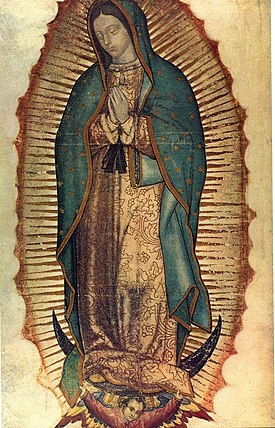The Virgin of Guadalupe is one of the titles given to Mary, the mother of Jesus, following four appearances she made to a Mexican peasant in 1531.
Missionaries who first came to Mexico with the Spanish conquistadors had little success in the beginning. After nearly a generation, only a few hundred Native Mexicans had been converted. Whether they simply did not understand Christianity or whether they resented these people who made them slaves, the new religion was not popular among the native people.
Then miracles began to happen.
Juan Diego was an Aztec Indian, 56 years old, who had recently converted to Catholicism. On December 9, 1531, he was walking through the Tepayac hill country in central Mexico on his way to Mass.
Suddenly a beautiful woman appeared before him and spoke to him in his native tongue. She told him she was Mary, mother of the God who is Lord of heaven and earth. She asked him to go to the bishop and request that church be built in her honor at the place where they were standing.
Juan did as he was asked, but Bishop-elect Zumarraga did not immediately believe him. He told Juan he would consider the request and sent him on his way. Feeling discouraged, Juan returned to the hill where he had met Mary, and found her waiting for him.
On hearing the Bishop's response, she instructed Juan to return and ask the Bishop again. She asked him to return the following day with the Bishop's reply.
 The Bishop, after hearing Juan's
story again, said he wanted the lady to give him a sign, something that proved
she really was who she claimed to be. Dutifully, the message was relayed to the
beautiful lady. She promised the sign would be given when Juan returned the
following day.
The Bishop, after hearing Juan's
story again, said he wanted the lady to give him a sign, something that proved
she really was who she claimed to be. Dutifully, the message was relayed to the
beautiful lady. She promised the sign would be given when Juan returned the
following day.However, Juan was delayed. His Uncle Bernardino was dying of a fever, and his nephew ran to a nearby convent to find a priest. Juan ran around on the other side of the hill to avoid the lady. He felt he had no time for another trip to the Bishop right then. However, Mary came down the opposite side of the hill to meet him.
She assured him that his uncle was cured, and Juan believed her. She then instructed him to go to the hilltop and gather the roses he found there. Even though it was winter, Juan found a bed of beautiful white roses blooming exactly where the lady had indicated.
He put a good number of them into his cloak or tilma and returned. The Holy Mother rearranged the roses, and instructed Juan to leave them untouched and unseen until he reached the Bishop.
When he came into the presence of the Bishop, Juan opened his cloak. The roses, fresh and wet with dew, fell to the floor. Juan raised his eyes and was startled to see the Bishop and his attendants kneeling before him. A life-size picture of the Virgin Mother, just as Juan had described her, glowed on the inner surface of the tilma.
Leaving the cloak with the Bishop, Juan returned to his village. He was met by his uncle, who was perfectly well. Bernardino also had a story to tell. He had met a young woman, surrounded by a soft light who told him that she had sent his nephew to Mexico City with a picture of herself. She asked, "Call me and call my image, Santa Maria de Guadalupe".
The picture was honored, guarded well in the Bishop's chapel, and was soon carried in solemn procession to the preliminary shrine that had been constructed where Mary had asked.
The miraculous events convinced many of the native people that Christianity offered something of significant value after all and within a short time six million Native Mexicans had been baptized.
Today, a magnificent basilica, in which the tilma is displayed, sits at the location of the apparitions. It is the most popular religious pilgrimage site in the Western Hemisphere.
For 500 years, in spite of many hazards: smoke from fires and candles, water from floods and storms and in 1921, a bomb blast, the tilma shows no sign of deterioration. It underwent scientific investigation in 1977. No one can explain the longevity of the image or its method of production.
Juan Diego spent the rest of his life as a hermit, and as caretaker of the chapel at Tepayac Hill. On July 31, 2002, he was cannonized a saint by Pope John Paul II in Mexico City. He is the patron of indigenous people and his feast is celebrated on December 12th.
No comments:
Post a Comment